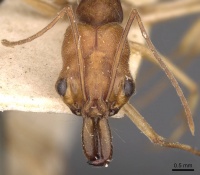Odontomachus biolleyi
| Odontomachus biolleyi | |
|---|---|

| |
| Scientific classification | |
| Kingdom: | Animalia |
| Phylum: | Arthropoda |
| Class: | Insecta |
| Order: | Hymenoptera |
| Family: | Formicidae |
| Subfamily: | Ponerinae |
| Tribe: | Ponerini |
| Genus: | Odontomachus |
| Species: | O. biolleyi |
| Binomial name | |
| Odontomachus biolleyi Forel, 1908 | |
Identification
A member of the Odontomachus haematodus group.
Keys including this Species
Distribution
Latitudinal Distribution Pattern
Latitudinal Range: 19.58333° to 17.36555556°.
| North Temperate |
North Subtropical |
Tropical | South Subtropical |
South Temperate |
- Source: AntMaps
Distribution based on Regional Taxon Lists
Neotropical Region: Costa Rica (type locality), Mexico.
Distribution based on AntMaps
Distribution based on AntWeb specimens
Check data from AntWeb
Countries Occupied
| Number of countries occupied by this species based on AntWiki Regional Taxon Lists. In general, fewer countries occupied indicates a narrower range, while more countries indicates a more widespread species. |

|
Estimated Abundance
| Relative abundance based on number of AntMaps records per species (this species within the purple bar). Fewer records (to the left) indicates a less abundant/encountered species while more records (to the right) indicates more abundant/encountered species. |

|
Biology
Castes
Nomenclature
The following information is derived from Barry Bolton's Online Catalogue of the Ants of the World.
- biolleyi. Odontomachus biolleyi Forel, 1908b: 35 (w.q.) COSTA RICA.
- Type-material: syntype workers, syntype queens (numbers not stated).
- Type-locality: Costa Rica: Pacific Coast, Manglares, mouth of Jésus Maria (river) (P. Biolley).
- Type-depository: MHNG.
- Wheeler, G.C. & Wheeler, J. 1952c: 651 (l.).
- Status as species: Emery, 1911d: 114; Kempf, 1962b: 17 (in key); Kempf, 1972a: 170; Brown, 1976a: 103; Bolton, 1995b: 295.
- Distribution: Costa Rica.
Description
References
- Forel, A. 1908c. Fourmis de Costa-Rica récoltées par M. Paul Biolley. Bull. Soc. Vaudoise Sci. Nat. 44: 35-72 (page 35, worker, queen described)
- Wheeler, G. C.; Wheeler, J. 1952c. The ant larvae of the subfamily Ponerinae - Part II. Am. Midl. Nat. 48: 604-672 (page 651, larva described)
References based on Global Ant Biodiversity Informatics
- Dattilo W. et al. 2019. MEXICO ANTS: incidence and abundance along the Nearctic-Neotropical interface. Ecology https://doi.org/10.1002/ecy.2944
- Del Toro, I., M. Vázquez, W.P. Mackay, P. Rojas and R. Zapata-Mata. Hormigas (Hymenoptera: Formicidae) de Tabasco: explorando la diversidad de la mirmecofauna en las selvas tropicales de baja altitud. Dugesiana 16(1):1-14.
- Gove, A. D., J. D. Majer, and V. Rico-Gray. 2009. Ant assemblages in isolated trees are more sensitive to species loss and replacement than their woodland counterparts. Basic and Applied Ecology 10: 187-195.
- Vásquez-Bolaños M. 2011. Lista de especies de hormigas (Hymenoptera: Formicidae) para México. Dugesiana 18: 95-133

